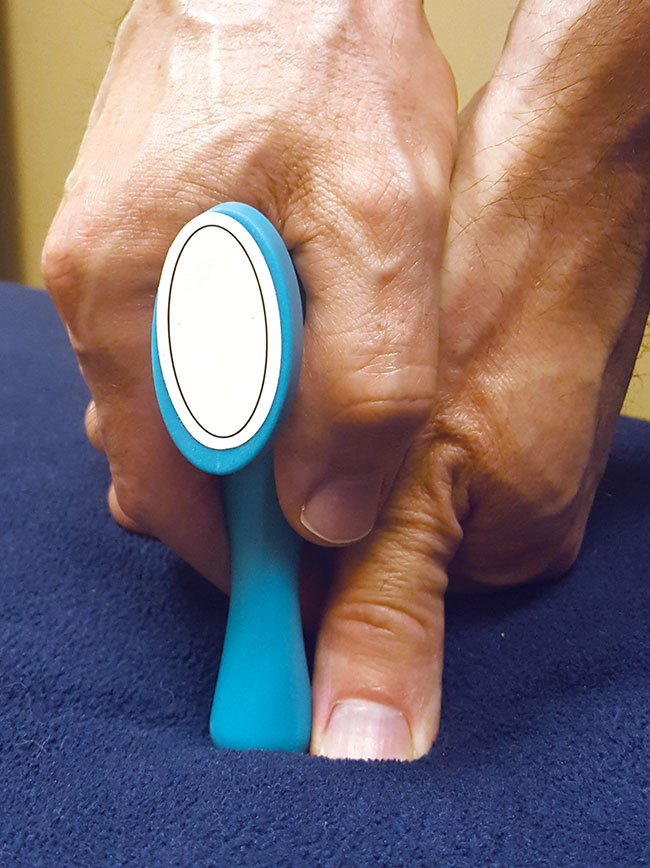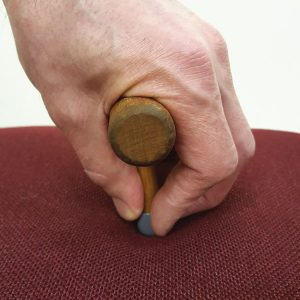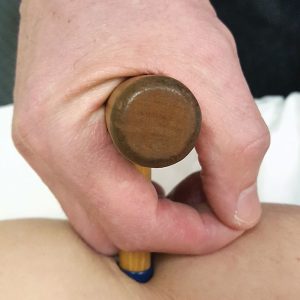
Features
RMTs: Stop pressing with your thumb for pain-free hands
July 2, 2022 By Mark Liskey, LMT
 Using a guide finger will help stabilize the massage tool so that you won’t have to tighten your grip around the T-bar if you need more pressure.
Photos provided by the author.
Using a guide finger will help stabilize the massage tool so that you won’t have to tighten your grip around the T-bar if you need more pressure.
Photos provided by the author. When I first started massage thirty years ago, I assumed that achy fingers and thumbs were part of the job. In other words, if you’re going to do massage, your hands will hurt. Period. It was only about seven years ago that I discovered that I was dead wrong – we can work pain-free.
At the time, my body was falling apart and I was on the verge of quitting massage. For the next year, I experimented in my massage room with different strategies and techniques to save my body. Figuring out how to save my hands took a while, but at the end of the day, one strategy stood out from all the rest: Use fingers and thumbs to sense but use a massage tool to press. Did you just think: “check, please”?
It’s okay if you did. In fact, many massage therapists do. After all, massage tools are hunks of wood or chunks of plastic. How are you supposed to feel the tissue with something that’s not hardwired to your brain? I have a workaround for that, but first, let me show you how to effectively and effortlessly use a massage tool to replace a finger or a thumb. To do that, I need to back up for a minute.
My story with massage tools
I was first introduced to massage tools when I was training to become a neuromuscular massage therapist (NMT). NMT involves a lot of precise pressing on muscle bodies and attachments. It didn’t take me long to realize that if I pressed all day with my thumbs, I’d have a short NMT career. NMT had an alternative for pressing with a thumb – a T-bar.
Initially, the T-bar was a perfect thumb replacement, especially in the lamina groove when working the multifidus and rotatores, the deep postural muscles. But as I continued to use the T-bar on a regular basis, my distal finger joints started to hurt. There’s a simple explanation why the tool that saved my thumbs, now hurt my fingers. Take a look at how I’m holding the T-bar, above.
See how my fingertips are gripping close to the tip of the T-bar? They’re gripping for a reason – to steady the massage tool in my hand when I exert medium to deep pressure. Without the gripping, the tool slips out of my hand.
To get a better idea of what I mean imagine using a screwdriver. As a screw gets harder and harder to turn, you must grip the screwdriver tighter. The same is true when holding the T-bar with fingertips around the stem – the more force you exert, the tighter your grip on the T-bar becomes.
For most of my massage career, I had a love/hate relationship with my T-bar. I’d use it until my fingers hurt, then I’d switch to thumbs. The problem with this approach was that I was either taxing my thumbs when I wasn’t using the T-bar or I was straining my fingers when I was using the T-bar, which meant some part of my hand always ached.
I began to solve this conundrum during my year-long experiment when I decided that the primary way that I was going to generate force was to lean.
When you lean, you’re using your body weight to apply pressure. That takes your upper body out of the strain equation because you no longer have to use your arms and shoulders to generate force.
The leaning strategy is applicable to massage tools. If you lean into the massage tool, you can pin the massage tool between your hand and the tissue you are working on.
Pin the massage tool
Once you pin the massage tool you can relax the hand that is holding the massage tool. Can you see my fingers saying “ahh”? (Image above.)
Using your body weight to pin the massage tool may require you to experiment with different table heights in order for you to get enough leaning leverage.
An easy way to start leaning with a massage tool is to sit and lean because you will be leaning with your torso only and you can adjust your stool height to find the best leaning-leverage position.
There’s one more step to using a T-bar without hurting your hands and that is to add a guide finger.
Use a guide finger
Think back to the screwdriver example. The one hand holding the screwdriver has to do everything – steady and turn the screwdriver at the same time, which results in a tighter grip on the screwdriver when the screw gets harder to turn.
Now imagine using a massage tool. When doing light pressure you can keep the tool upright by simply pinning it. However, when you increase the pressure, it’s like turning the screwdriver, and you need to either grip the massage tool harder or add additional support to stabilize the massage tool. The additional support is a guide finger. A guide finger next to the massage tool acts as a brace. The two strategies, pinning and bracing, used together will keep the massage tool steady in your hand at medium and deep pressure.
By the way, a guide finger doesn’t have to be a finger or a thumb. It can be any part of the hand that’s not holding the massage tool, like a knuckle(s) or a fist.
There’s an added bonus when you use a guide finger. It can be used to sense and palpate.
Guide finger for sensing
You never again have to worry about losing your sense of feel with a massage tool when you have a guide finger down next to the tip of the massage tool. Why? Because the guide finger is connected to your brain. Depending on which direction you’re moving with the massage tool, the guide finger relays information about where you’ve been (what you’ve just worked with the massage tool) or where you’re going (what’s ahead that you may want to work with the massage tool).
As you practice with a guide finger you’ll fall into a massage rhythm which may go something like this: Find the spot you want to work with the guide finger and then press with the massage tool. After you press with the massage tool you can then check the spot you pressed with the guide finger.
Warning: You will be tempted to use your guide finger as the main presser instead of the massage tool. Old habits die hard. But there’s an easy fix for this: Just lean into the massage tool when you feel yourself pressing with your guide finger. Eventually, your guide finger will get the message.
Here’s one more tip that will help with your ability to sense the tissue you’re working on when using a massage tool: Do an exploratory stroke.
If I’m working back muscles, I start off by doing a massage stroke with my hands (no massage tool), usually knuckles and fists, to find the areas that I want to address. Once I have that general road map, it’s easy to locate those areas without having to search with my guide finger.
How to use a massage tool in a nutshell
That’s it. You now know how to use a T-bar to replace your thumbs and fingers without losing sensitivity. The first step is to lean and pin the massage tool between your hand and the client’s tissue. If you are new to leaning to generate force, sit and lean using your torso.
Once you have the T-bar pinned place a guide finger from the hand that isn’t holding the massage tool next to the stem of the massage tool. The guide finger will help stabilize the massage tool so that you won’t have to tighten your grip around the T-bar if you need to apply more pressure. The guide finger then can also be used to palpate and provide feedback regarding areas you may want to press with the T-bar or areas that you have pressed with the T-bar.
You can also do an exploratory stroke before you use a massage tool to get the “lay of the land” so that you know exactly where you want to use your T-bar.
The lean, pin, and add guide finger steps can be used with any massage tool that’s designed to press. You’ll have to experiment to find out which massage tool is the best fit for you.
Ultimately, it took me way too long to understand that I can’t take care of my clients if I don’t first take care of me – and that late lesson almost cost me my career. It doesn’t have to get to that point with you. Start taking care of you in the massage room by experimenting with a massage tool.
MARK LISKEY is a massage therapist of 30 years, CE teacher/provider and massage business owner. His blog www.makethemostofmassage.com provides massage therapists with the extra knowledge and specific tools to massage pain-free. Take the massage pain-free quiz and get an instant video to help you solve your pain issue: https://www.makethemostofmassage.com/can-you-massage-pain-free/.
Print this page

